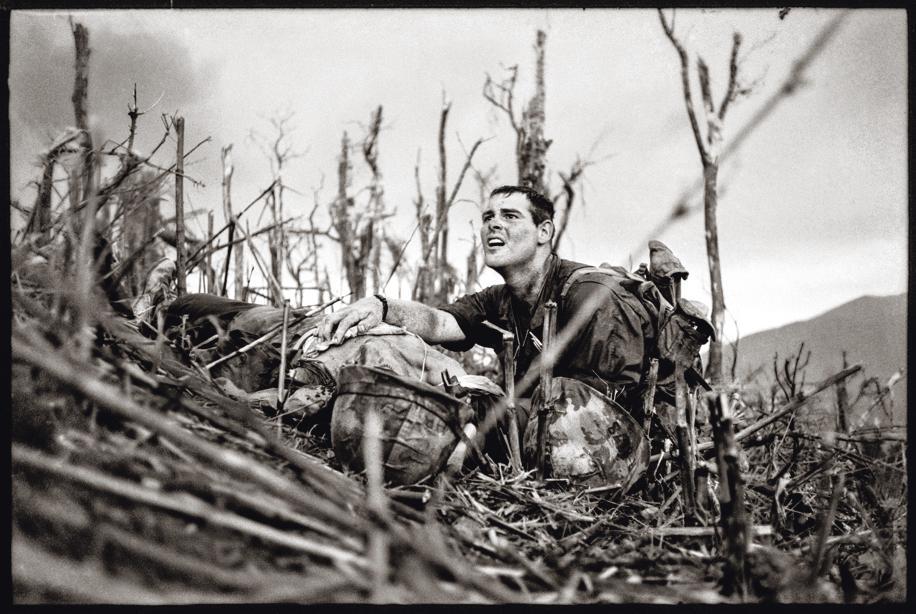From 1936 to 2011, Gerda Taro, Lee Miller, Catherine Leroy, Christine Spengler, Françoise Demulder, Susan Meiselas, Carolyn Cole and Anja Niedringhaus covered seventy-five years of international conflicts, showing the intimate as well as the military, violence like coming back to life.
But, like painters or novelists, their work remains less valued than that of their male counterparts.
The Musée de la Liberation in Paris restores the balance by devoting the exhibition Women Photographers of War (1) to them, from March 8 to December 31.
“Through this corpus, we tell a story of the war, in its conduct, its armament, its combatants or its nature.
But we also tell the evolution of the place of women photojournalists”
,
explains Anne-Marie Beckmann, scientific curator of the exhibition co-organized with the Kunstpalast in Düsseldorf.
“Most of these women were published 'on the spot' and then forgotten.
We wanted to take them out of this ephemerality and show the full power of their work.”
Read alsoUpset, an interpreter bursts into tears in the middle of a speech by Ukrainian President Zelensky
Trust capital
The installation questions the visitor: is there a
female gaze,
a gaze specific to these photographers?
According to Anne-Marie Beckmann, "for decades, as none of them had access to the front, they covered the hospitals, the civilian victims, the daily life of the populations... They continued to do so because the families, perceiving them as less dangerous, opened their doors more easily to them, but from the Spanish war and especially in Vietnam, they also worked with the combatants.
In video, look back at the career of Peter Lindbergh
The French Catherine Leroy thus immortalized the clashes between the Marines and the Vietcong, including in their brutality, when the American Susan Meiselas had access to the guerrillas of Nicaragua.
“I documented violence in Central America, but also everyday scenes that some considered less essential,” explains the Magnum photographer, also featured in the gallery of the famous agency (2).
“Does this bias exist because I am me or because I am a woman?
I can't say."
From victims to witnesses
Either way, their courage and convictions have pushed the boundaries for female photographers and challenged the stereotype that invariably associates women with emotion and men with action.
Without a signature, the well-advised observer would be able to identify the sex of the photographer.
The shots of the German Gerda Taro during the Spanish Civil War were also long credited to Robert Capa, the pseudonym of her illustrious companion.
Thanks to these pioneers committing their own bodies in the field (Gerda and Anja Niedringhaus lost their lives there), the very status of women in times of war was changing: once only victims, they became combatants and photographic subjects, or witnesses behind the lens.
And, for the latter, without giving in to what could be expected of them.
In Afghanistan, Anja Niedringhaus, then embarked by the army, had her accreditation withdrawn after having photographed a man, knees on the ground, bag on his head.
The potential of female war photographers is still not fully realized
Susan Meiselas
Susan Meiselas was criticized for her use of color in Central America.
“I also worked in black and white, but in Nicaragua what caught my eye was the color of the clothes, the houses, the blood… It was impossible for me to miss it, but I was told that my color embellished the subject.
Above all, I think it made it less “romantic” than black and white.”
One of his photos, showing a mutilated body and published in the Magnum agency's anniversary book
In Our Time
(Éditions Andre Deutsch Ltd), was thus excluded from an exhibition that followed the publication.
“They thought the public wouldn't put up with it.
But the Nicaraguans, they lived with these images… It is sometimes difficult to find the balance between what is appropriate to show and what is necessary to see.
An unrecognized potential
Since the Internet, however, perception has evolved.
"The public today is ready to welcome other images, if they are contextualized, that they are not presented frontally, in an isolated manner", explains Sylvie Zaidman, director of the Museum of the Liberation.
“It is an even more necessary educational work with color war photos.
In the collective unconscious, black and white imposes a distance that makes things more acceptable.”
The advent of digital has brought other changes to the profession, specifically for women war photographers, now able to share the fruits of their labor quickly and widely.
If the agencies, listening to societal changes, have opened up to more parity, many are still those who leave without a mission.
“The potential of female war photographers is still not fully realized.
We multiply the male points of view, but we imagine that the look of a single woman is enough.
Our testimonies are however as multiple as our personalities”, concludes Susan Meiselas.
“When I left on my own to Central America, I was not considered a reliable witness…until my pictures proved otherwise.
I say this to the younger generations of women who would like to follow in our footsteps: don't wait to be given your place, take it.
(1)
Women war photographers,
from March 8 to December 31 at the Paris Liberation Museum-General Leclerc Museum-Jean Moulin Museum, in Paris.
museeliberation-leclerc-moulin.paris.fr.
(2)
Carnival Strippers Revisited,
until April 30, at Galerie Magnum, at Paris.magnumphotos.com

